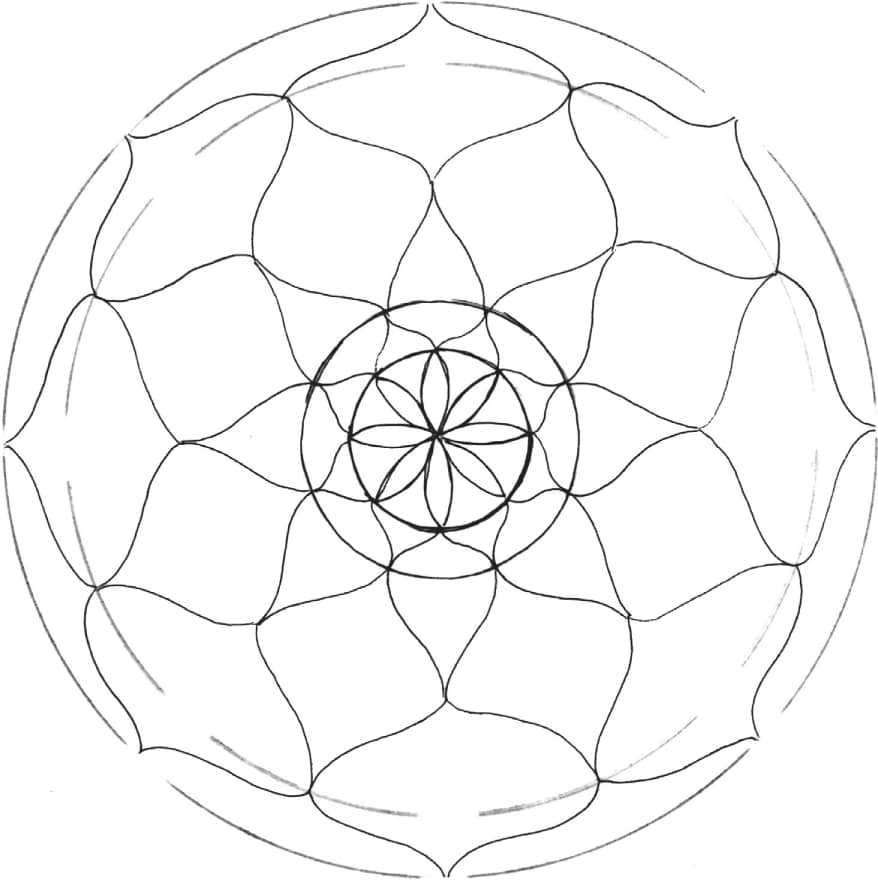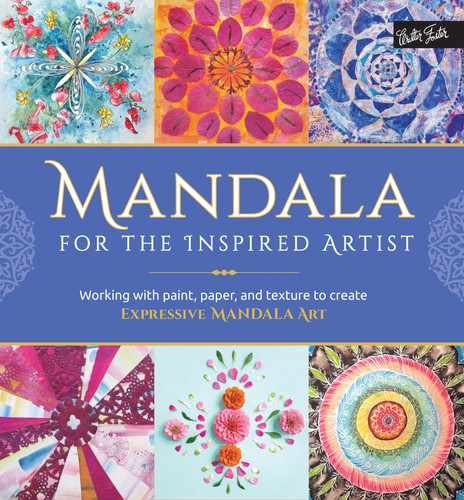Drawing & Coloring Mandalas
LOUISE GALE

 Drawing Mandalas
Drawing Mandalas
LOOKING FOR INSPIRATION

Mandala inspiration is all around us, in our homes, in man-made designs, and—most abundantly—in nature. Look for the mandalas around you, and notice the beautiful designs, motifs, and patterns in fabric designs, candle holders, a slice of lemon, the macro center of a flower, or a delicate urchin on the beach.
GETTING STARTED
Before you begin your mandala, create a space for yourself that is comfortable, inspiring and free of distraction; then consciously slow your breathing and calm your mind. This may be as simple as taking three deep breaths. The process of drawing or coloring a mandala can be a calming and meditative experience, so be mindful of enjoying the moment. Let any thoughts that arise just drift through your mind. Perhaps you might play a favorite calming tune to help you relax. There are many different ways to approach drawing a mandala. In this introduction, you’ll find a simple doodling and motif exercise, a freehand approach, and a structured approach—all of which you can use as a foundation for your mandala designs. Whether you strive for structure or love to doodle, you will find endless joy in drawing and coloring many different types of mandalas!
 MATERIALS
MATERIALS
• Compass and pencil
• Protractor
• Ruler
• Black pen
• Eraser
• Colored pens, pencils, or crayons
DOODLE IN A CIRCLE
Doodling inside a circle is a great way to get started with mandala making. It’s all about exploring the possibilities inside a simple circle, so you can start small and expand your circles and the number of motif designs as you become more confident.
Use a compass to draw a small circle (about 4" in diameter), or you can trace a small dish or plate. Draw a simple shape inside, such as a flower, a swirl, lines bursting from the center, or repeated petals. Doodle a variety of circles to help loosen you up. Pay attention to the types of motifs or shapes that you are drawn to the most as you doodle.
Here are some of my examples:

IDENTIFYING & BUILDING YOUR OWN UNIQUE MOTIFS
When you closely study more detailed mandalas, you’ll start to identify the beautiful motifs the creator has used. If you are very new to drawing mandalas, study a few of your favorite mandala images and pull out your favorite motifs for inspiration. Then start a page in your sketchbook of your own unique doodles and motifs. Below are some of my favorite doodles, which I use in many of my own mandalas.


Photocopy or trace over this circle; then doodle inside to warm up or use it as a template for your designs. You can download and print any templates from this book by visiting this link.
GROW A MANDALA
This is a completely loose and freeing way to create a doodled mandala. Start by drawing one motif in the center of your page, such as a dot or a flower. Then “grow” the mandala outward repeating your favorite icons or motifs around the central focal point. For example, if you start with a flower that has eight petals, repeat your next motif in the spaces between the petals eight times and so on.

CREATE A STRUCTURED MANDALA
Creating a structured mandala is a great way to guide your mandala creations if doodling freehand does not come easily at first. I like to create a grid to guide my mandalas, but also include an element of looseness when I draw motifs so it still has a hand-drawn effect. The resulting mandala feels symmetrical, but isn’t 100% symmetrical because it is hand-drawn. As with all mandala creations, there are endless possibilities for design and structure, so enjoy exploring and creating your own unique mandalas. Soon you will soon find a flow and style that you love.
 ARTIST’S TIP
ARTIST’S TIP 
Divide the number of sections you want in your mandala by 360. The result is the number of degrees to mark your points with using your protractor.

STEP 1
Draw a circle with your compass and pencil. Then line up a protractor to mark the number of points you would like to create around the circle. For an eight-point mandala, the points will be separated by 45 degrees around the protractor (360/8=45). Use a ruler to join the points, creating eight equal sections. Then use the compass to draw a series of concentric circles, varying the gap size. I added four circles.

STEP 2
Now you’re ready to start drawing your mandala in pen. Starting at the center, choose one motif to repeat in each of the eight sections within that circle. You can draw on the lines themselves or in the space between.

STEP 3
Move outward through each section, connecting the points where the lines meet to create a new motif, so the design flows together. In the second circle, I drew a lotus petal, connecting the edges of the petal with the tip of the central motif. In the third circle, I drew larger petals again connecting the edges with the previous motif.

STEP 4
Now you have the base of your mandala and can add more detail. You can keep all of your original grid lines in place, or you can erase some of them to open up the design. I erased all of the straight lines and the central circle.

STEP 5
Add lines and other motifs to your mandala. Let your intuition guide you as you draw and add beautiful detail. When you’re done, erase any remaining pencil lines.
 ARTIST’S TIP
ARTIST’S TIP 
Photocopy your mandalas, and experiment with different color combinations using the color theory section.

 Coloring Mandalas
Coloring Mandalas

Coloring mandalas as a regular creative practice can be very therapeutic. Color is a personal choice, so when you’re selecting your palette, tap into your intuition to pick those that are speaking to you on that particular day. For a little more inspiration, follow these color theory basics to create harmony in your artwork.
THE COLOR WHEEL
The color wheel is a great tool for artists and designers. You can use this as a resource to get a feel for how color works as you select color combinations for your mandala artwork.
WARM & COOL COLORS
The color wheel is divided into warm and cool colors. Using either a warm or cool palette will create harmony in your artwork.
MONOCHROMATIC
If you have a favorite color, create a mandala in shades of that color. Monochromatic color schemes can be calming or energetic, depending on which side of the color wheel you use.

COMPLEMENTARY COLORS
Complementary colors sit directly opposite each other on the color wheel. They balance each other perfectly and make each other “pop.”

ANALOGOUS COLORS
An analogous color scheme uses three colors that sit beside each other on the color wheel. This kind of color scheme is very harmonizing.

 ARTIST’S TIP
ARTIST’S TIP 
Explore and collect your own favorite color palette combinations. Take your camera on a walk and photograph colors that inspire unique palettes and combinations for your artwork.

Photocopy this template; then choose a color scheme, and color in this mandala with colored pencils, pens, or markers. You can download and print any templates from this book by visiting this link.
